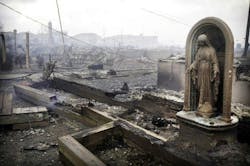Fighting a Multifamily Building Fire amid a Flood and a Superstorm
A multifamily building fire during a flood and a major storm system isn’t an everyday event, but it’s good to prepare for worst-case scenarios. The adage, “Train the way you fight, and fight the way you trained,” is true even in catastrophic events that, thankfully, don’t happen often.
The following lessons learned were the result of fighting a residential fire on Oct. 29, 2012, during Superstorm Sandy.
Flooding and apparatus
In a flood situation, it’s important to know the location of fire hydrants. Deep-water flooding might obscure a hydrant’s location just as a snow drift can during a blizzard. However, in a flash-flood situation, there might be insufficient time to attach hydrant location markers in advance.
Anticipate in a flood scenario that certain roads might become impassable, which would require alternate routing. FEMA developed flood maps to address peak flood conditions for locations throughout the country.
It’s important to develop a thorough understanding of weather Alerts, Watches and Warnings. The National Weather Service also produces alerts for floods and estimations of severity. This information, combined with an enhanced understanding of weather processes, helps firefighters and leadership to make effective decisions that ensure success and the safety of personnel and equipment.
Chauffeurs and leadership should have a clear understanding how the depth of water can affect fire apparatus’ operation without becoming disabled. The limiting factors are the height of the carburetors in the engine compartment and the location of the exhaust pipe on the vehicle. Combustion engines in fire apparatus are like lungs in the human body. They must be capable of inhaling and exhaling without obstruction to operate correctly. When the intake and exhaust systems become blocked, the engine will fail to operate.
The higher the air scoops are for the carburetor, the better off we are.
It’s the same for the exhaust system. Many fire vehicles’ exhaust pipes are under the body of the rig near the rear. This limits the depth of operation. Some apparatus manufacturers offer a “snorkel exhaust,” which rises above the hose deck and allows for operation in deeper water.
An understanding of the depth of water in which a vehicle can operate in a flood scenario allows leadership to make an accurate call in go/no-go decisions.
As the apparatus manufacturing industry moves to hybrid and all-electric vehicles, we must be mindful of how new technology, such as lithium-ion batteries, affects operations in flood conditions, particularly in salt water.
Many newly manufactured apparatus are equipped with high-tech features that support modern electronic equipment. The wiring and associated diodes for this equipment should be hardened, waterproofed and located at the highest points to allow for operation in water, again, particularly salt water.
Many departments operate shallow-water boats that are essential in water rescue operations. This equipment must be properly maintained, and personnel must have appropriate survival gear and be trained on the equipment.
Planning
In the case of a multifamily building fire during a flood and storm situation, planning drills and tabletop exercises should consider the collapse of multiple structures, which might lead to a loss of water pressure. Advance plans should be developed to address these situations. Consideration should be given to alternate sources of water, such as tanker trucks and drafting from swimming pools, ponds, lakes and other water sources.
With standing water from a flood, even five-gallon buckets that are stored on a rig could help to knock down a fire or at least to slow down its advancement.
Planning drills for a fire during concurrent multiple disaster conditions, such as a flood and a major weather event, should consider the need to evacuate survivors to a safe location. Plans should include an advanced knowledge of sites to use as a public shelter.
Evacuations
Departments should consider education of community residents on how to prepare for an impending disaster. Working with the local press and media outlets helps to get out this message.
The importance of compliance with advance evacuation orders is essential. Often, because a previous storm was hyped to be devastating but later took a turn, which resulted in a nonevent, many people have made the advance decision to ignore future evacuation orders.
Any evacuation plans should give high priority to senior citizens and to those who have a serious illness and/or a mobility issue.
All evacuation plans should make special considerations for the evacuation of pets.
Training
During an event when multiple disasters can occur concurrently, fire department leadership must ensure that they have the proper equipment and training in place to handle all of the challenges that they will face.
Sometimes when routine training drills are scheduled, the local area might be experiencing some inclement weather. The temptation is to cancel an outdoor drill and conduct an inside drill. Depending on conditions, an outdoor drill in some degree of inclement weather might provide benefits: Firefighters experience a mild form of adverse conditions, which makes their training more realistic.
When conditions are too hazardous to train outdoors might be an excellent time to conduct a tabletop exercise to review plans and to ask what-if questions, so the team can anticipate problems in advance.
Exposures
While fighting a multifamily building fire in a severe storm, high winds might cause embers from collapsing building structures to be lifted into the air stream, which could cause the fire to jump. If there are enough resources available, consideration should be given to establishing a secondary line of defense to stop the fire from spreading. Any effort from inside of the fire to prevent the embers from becoming airborne is helpful.
If the fire becomes so big that it threatens to advance rapidly, consideration should be given to other means of creating a fire break in a flooded environment. Bulldozers and other heavy machinery might be utilized.
Firefighter stamina
Fighting a major fire in a multiple-disaster environment is very time-consuming. Firefighters will be exposed to conditions that will cause dehydration and exhaustion. Training drills should include awareness of these problems and procedures for rehydrating firefighters and obtaining necessary crews to allow for rest and breaks.
As is the case with all training, the more that you focus on your basic firefighting skills, the greater your opportunity to be successful.
About the Author

Marty Ingram
Marty Ingram is past chief of the Point Breeze Volunteer Fire Department in Breezy Point, NY. He was the chief during Superstorm Sandy. Ingram is a retired U.S. Air Force Lieutenant Colonel and was an air rescue helicopter pilot and emergency planning officer. In 2013, he was selected as the New York State Volunteer Fire Chief of the Year. Ingram was appointed as an FDNY Honorary Battalion Chief. He is the author of “Flood, Fire and a Superstorm," which was published by Outskirts Press.
